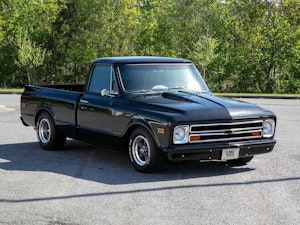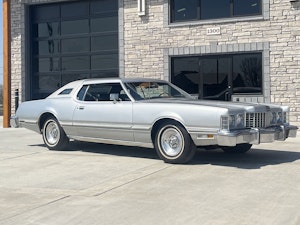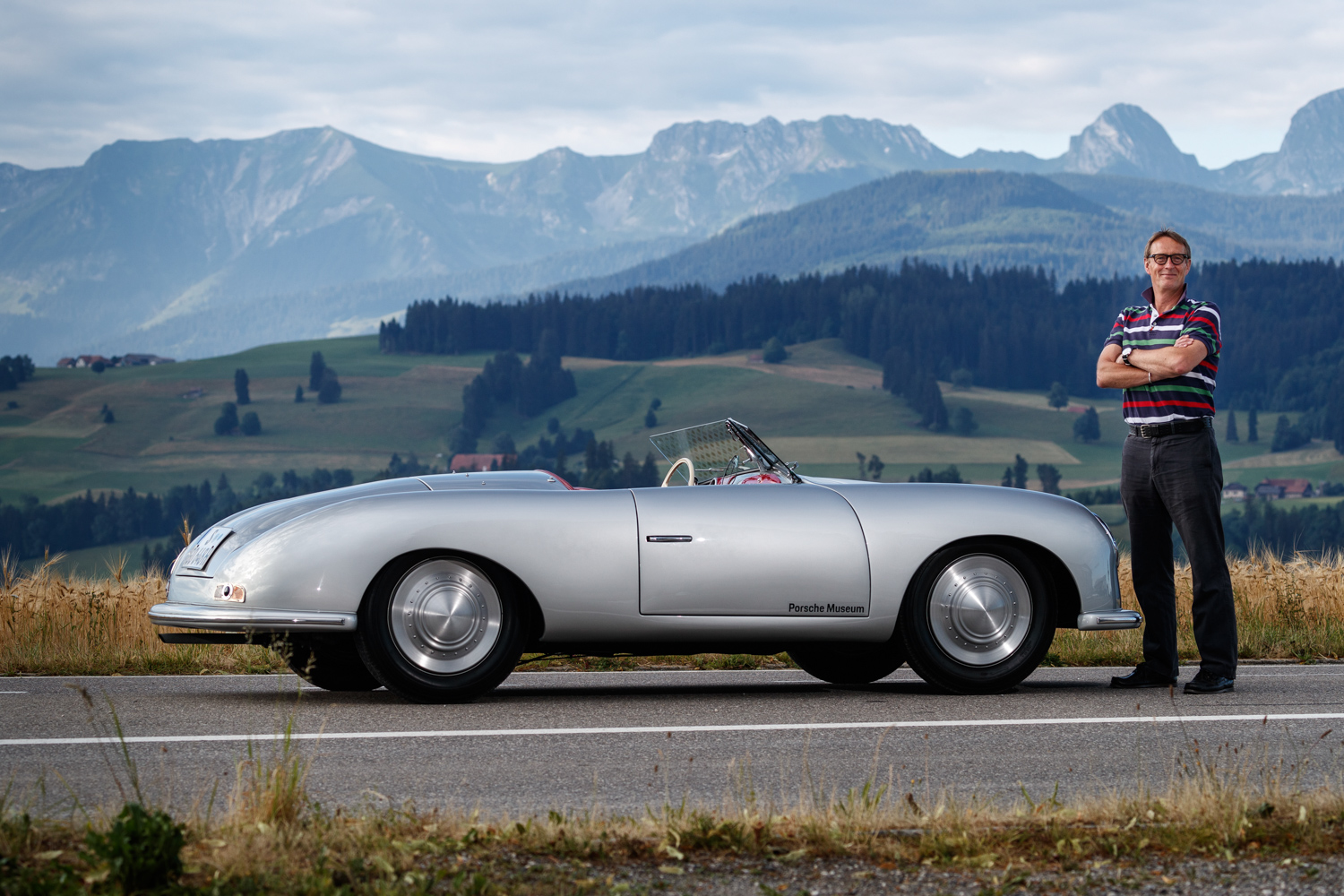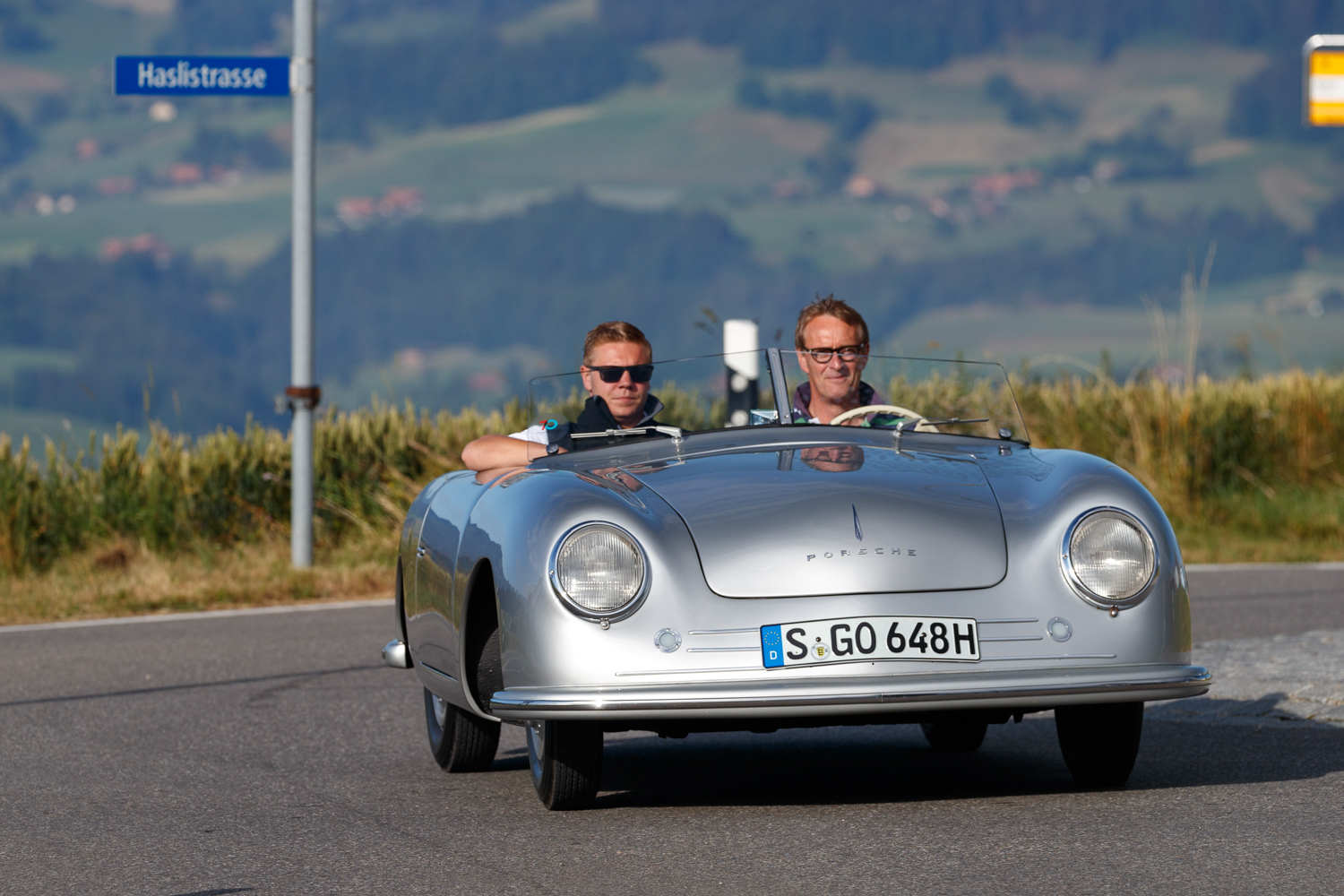Media | Articles
What it’s like to drive the very first Porsche car
“Don’t mention the war! I mentioned it once, but I think I got away with it,” says John Cleese as Basil Fawlty in The Germans, an episode of the 1970s TV comedy Fawlty Towers. Ironically, the series still has a huge following in Germany, where lines are still quoted. But like Basil Fawlty, I’m going to have to mention the war, for it was then and in the preceding years that we find the birth of Porsche’s carmaking past.
And it is this car, overheated and cooling by the side of the road in the Swiss Alps, bearing the stamp 356001 on the bulkhead, where it all started. For those who say that Porsches are just gussied-up Volkswagen Beetles, this is absolute proof. But when did a Beetle ever look this good?
This first 356 is very different from the production 356, which was undergoing simultaneous development in 1947–48. To understand why this car is a mid-engined two seater instead of a rear-engined two-plus-two like the majority of the rest of the 356 range, you need to go back to July 1947 and the first mention of what was dubbed the “VW Sport” in the meticulous diaries of Porsche engineer and manager Karl Rabe.
Ferdinand Porsche had just been released from a French jail where he and fellow director, and brother-in-law, Anton Piëch served 22 months for collaboration with the Nazis. Porsche’s son Ferry was released after six months and returned to the family firm which his father had founded in 1931. Porsche’s operations had been moved from Stuttgart to Gmünd in Austria to avoid Allied bombing during the war, but these were still tough times. Porsche and Piëch had written to exiled Porsche director Adolf Rosenberg in America begging for food and money, which he’d sent. Porsche seemed less keen on honoring this influential and much-wronged man when he tried to claim restitution, however. The issue was dragged through the courts until in 1950, when Rosenberg (who’d fled Nazi Germany before the war and changed his name twice), was awarded just 50,000 Deutsche Marks and a VW Beetle.
Marketplace
Buy and sell classics with confidence


Back at the family firm in 1946, Ferry Porsche buckled down and sought work, and Porsche had designed and built agricultural equipment, mowers, tractors, winches and water pumps, as well as providing contract work on the Type 1 Beetle. It was a contract from the Italian car maker, Cisitalia, however, to develop a grand prix car that got Porsche released from jail. Piero Dusio, Cisitalia’s owner, fronted up the bail so that Porsche could get to work redesigning the unraced Auto Union flat-12 supercharged 1.5-liter design as the Cisitalia 360.
And it was about then that Ferdinand and Ferry decided to build their own car. Alexander Klein, manager of Porsche’s historic car collection, thinks it was a natural step, probably born out of Porsche’s work on the Beetle-based Type 64 streamlined racing car in 1939 (a car that many believe was really the first-ever Porsche) and also seeing what Cisitalia were doing.
Rabe’s diary records just how much No. 1 owes to the Beetle; its tubular frame bookended with sturdy bulkheads, that mid-mounted VW, air-cooled single-cam engine, the front and rear suspension, worm-and-roller steering, 16-inch wheels, and Simplex cable-operated nine-inch drum brakes—all of it Beetle. And the lovely aluminium coachwork, mounted on the 85-inch wheelbase, was designed by Erwin Komenda in just a few weeks.

One look inside this little speedster shows that while its cabin is wide and seemingly spacious, the wide sills push the seats so close together that changing gears involves a fair amount of inadvertent knee touching between passengers. The dashboard is vastly more reduced than that on the production 356, with just a speedometer in front of the driver and a clock in front of the passenger. It’s charming and beautifully presented, but for well-upholstered post-war frames like yours truly, it’s just too small and I have to stare over the top of the frameless windscreen with the wind blasting straight into the face.
Why the mid-engine configuration? Klein says Porsche had experience of the layout with his designs for Auto Union and respected the handling virtuosity. “But it is a difficult layout for road cars,” he says, pointing out that it took another 16 years for the first production mid-engined car, the ATS 2500 GT to go into production. “And ergonomics were incredibly important to Porsche,” he says, pointing out that Porsche wanted a decent amount of space in the cabin and a practical two-plus-two car, and No. 1 is anything but.
“We built that car only for experience,” Ferry Porsche explained in 1984. “It was to see how light we could go and how many VW parts we would need.”


That mid-engine layout also means that No. 1 has a unique four-speed transmission, behind rather than in front of the engine. “We could fit a Beetle gearbox instead,” says Jan Heidak, engineer with Porsche’s museum, “but then we’d have four reverse gears and one forward.”
The car’s reversed Beetle suspension is a development of the Type 64’s arrangement, where the trailing arms become leading arms. While contemporary road reviews of No. 1 talk of the car’s stability, the wheel geometry changes if you lift off when fully committed in a corner, which would be fairly hair-raising. As it is, there’s not a huge amount of grip from the L-section Dunlop tyres.
No. 1 has a simple key start, and the familiar air-cooled rattle fills the air, more noticeable than that in a Beetle, as it’s right behind your ears. It’s hot, too, with the bulkhead too hot to touch and the seats warming quickly.
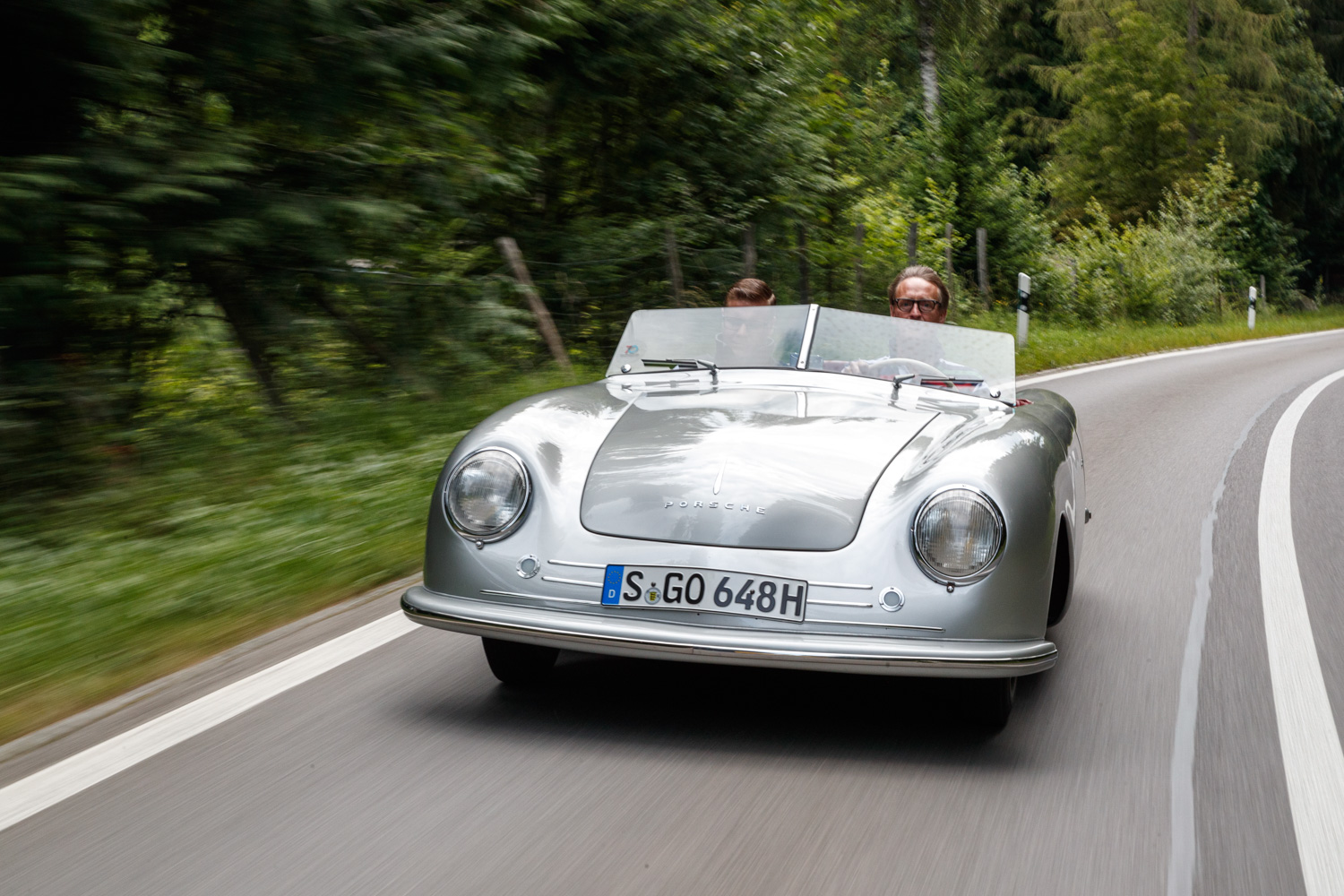
With no synchromesh on first and second, you have to double clutch the ratios of this delicate little transmission. Heidak nods his approval when a change goes well. Fourth is an incredibly long ratio so you seldom use it on the roads we’re driving around the Swiss Alps, where the car was originally developed. And you need to get handy with that transmission, too, since driving No. 1 is an exercise in maintaining momentum.
Despite a curb weight of just 1290 pounds, the 1131cc flat four engine can muster just 35 horsepower at 4000 rpm and 51 lb-ft at 2600 rpm. True, it’s more than the first Beetle, as Porsche had put a bit of love into the cylinder heads, but on modern roads it’s desperately slow with published 0–62 mph acceleration of 23 seconds and a top speed of 84 mph. In case you were interested, the gas mileage is 29–33 miles per gallon. The relative lack of vim is painfully illustrated when at one point we’re overtaken by a moped and fail to catch up.
But then the altitude and inclines start to take their toll. The engine is working hard and warming up, which thins the oil and reduces the cylinder pressure. I dance around the pedals trying to keep the revs up to maintain oil pump speed, double clutch, and maintain momentum.
“You have to do a Walter Röhrl on the pedals,” Heidak jokes as this priceless car’s red oil-pressure warning light winks on again.

We stop and let the engine cool before continuing with the engine cover removed so the hot air can escape. Rabe’s diary doesn’t mention an overheating problem, but they did have to strengthen the rear frame after it twisted on the Swiss Alps. On the narrow-but-well-surfaced Swiss mountain roads it rides well and corners reasonably on a constant throttle, and the tiny Beetle brakes are pretty strong.
The car made its debut at the Bern Grand Prix in July 1948 when journalists were invited to drive it. That included Robert Braunschweig from Automobil-Revue, which published the first road test. That September Porsche received an export licence for the new car and in December No. 1 became the first officially registered Porsche. It’s that first registration 70 years ago that Porsche is celebrating this year, taking the car to Classic Le Mans, Goodwood Festival, and a couple of U.S. events.
With nothing left to prove to Porsche, No. 1 was supplied to Swiss agent Bernhard Blank, who by chance had become a major investor and the company’s first salesman. He also arranged for the Beutler coachworks to inspect No. 1 and successfully bid for the work building bodies for the first 52 356 models in aluminium (later cars had steel bodies). Blank sold many of those first 356 models including No. 1, which went to Peter Kaiser, a Zurich architect, for 7500 francs—about $1715 at the time. It passed through about seven different sets of hands, and was even fitted with a modern 1.5-liter engine and new brakes by Porsche for one owner who wanted to race it. Porsche bought it back in 1958 (it was swapped for a new 356 Speedster) after its body had been modified to look like a Speedster. There’ve been various attempts to get it back to original condition, although as Klein wryly observes, “original condition” is the subject of some debate at Porsche. The paintwork for example is Boxster silver rather than the grey it would have been originally.


Not everyone likes Porsche and it isn’t difficult to see why; the company and owners have a reputation for arrogance, the early history is controversial, and the cars are controversially styled. Old No. 1 is special though, partly because of its absolute authenticity, and you can see that in the respect and care with which museum engineers treat it.
There’s also the fact that Komenda’s design is inch-perfect. This is a really pretty little car, much nicer than how the production 356 turned out. I kept thinking of Grant Larson’s 1993 Porsche Boxster concept compared with the less delicate 1996 production Boxster as a modern parallel, especially given the Boxster’s mid-mounted engine.
All the same, it wasn’t hard to hand the keys back to Heidak. Even dicing with mopeds can be unnerving in something so tricky to drive and so valuable, and that one-off gearbox is just terrifying. So many happy returns No. 1, and maximum respect to those who look after you.


